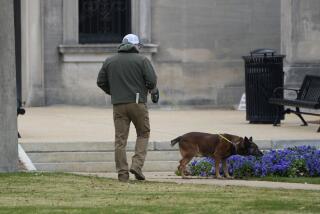2 States Seek Weak Links in Emergency Plans
- Share via
HILLSIDE, N.J. — A large anti-terrorism drill got underway Monday with a mock biological attack in New Jersey and a simulated chemical-weapons explosion in Connecticut.
Named TOPOFF 3, the $16-million, weeklong exercise is meant to find weak spots in the nation’s emergency planning.
“I want to make it clear that we are going to push our plans and our systems to the very limit,” U.S. Homeland Security Secretary Michael Chertoff said. “So we expect failure because we’re actually going to be seeking to push to failure, and that is, in our judgment, the best way to get a ‘lessons learned’ from what we do here.”
Although no real weapons or bio-agents were used, state and local officials responded as if the exercise were the real thing, sending ambulances to hospitals and flooding the area with investigators and emergency workers in hazardous-materials suits.
“It’s a test of how well people are communicating with each other and whether the right people are getting pulled into this exercise,” said Roger Shatzkin, a spokesman for New Jersey’s Office of Counterterrorism.
The biological attack drill started in New Jersey at the Hillside campus of Kean University with officers swarming around the scene of a mock auto wreck. A hose nozzle sticking out a rear window of one vehicle raised cautions; they found a commercial sprayer that presumably had been used to disperse a fake biological agent.
Officials also rolled in a bomb-squad robot with a mounted video camera to allow investigators to peer inside the suspect vehicle from a safe distance.
Doctors tried to connect the incident to a patient who had been admitted to a hospital with “flu-like symptoms.” More “victims” of the supposed biological attack headed to emergency rooms, and state health officials started zeroing in on pneumonic plague as the likely cause.
In Connecticut, federal officials staged a mock chemical weapons explosion on the New London waterfront. Buses were overturned to create a realistic scene, and volunteers played victims of the attack.
Connecticut Gov. M. Jodi Rell went into a conference call with Chertoff, declared a state of emergency and raised the state’s threat level. Representatives from all state agencies worked the phones as a virtual news broadcast kept officials updated.
In the federal command center in suburban Virginia, more than 100 officials hunched over laptops and picked up blinking phones as the test attacks began.
Today and Wednesday, the drill will shift to hospitals, where hundreds of mock patients will show up with medical crises.
More to Read
Sign up for Essential California
The most important California stories and recommendations in your inbox every morning.
You may occasionally receive promotional content from the Los Angeles Times.










